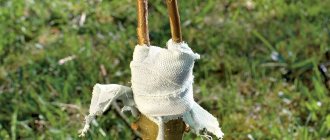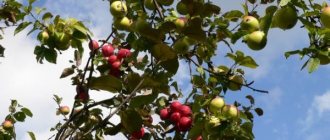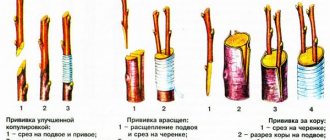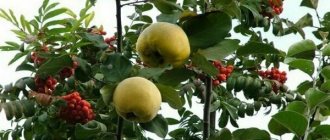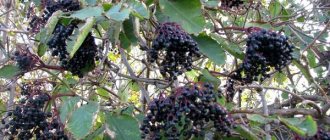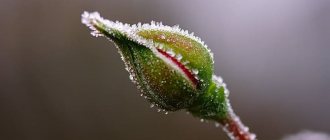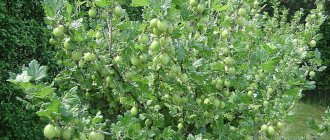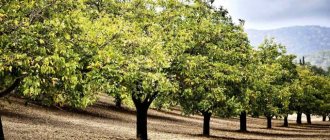The need for mulberry grafting
Might be interesting How to grow a walnut correctly Pruning an apple tree in the fall for beginners in pictures step by step Spring plum care, advice from experienced gardeners
They resort to mulberry grafting if the tree does not bear fruit. It belongs to dioecious plants. There are male and female trees. Both bloom, but only the latter's flowers turn into tasty berries after pollination. However, if a male mulberry grows in the garden, then you should not wait for the harvest, but you also do not need to uproot it. In this situation, grafting a cutting onto a male mulberry tree from a female tree will help.
This procedure is practiced if there is a desire to reduce the waiting time for the harvest. Instead of waiting 5-6 years, you can enjoy the berries after 2-3 years. By grafting a shield or mulberry cuttings onto a tree that is already accustomed to climatic conditions and soil, you can be sure that it will be able to be propagated. As a result of this procedure, different varieties can be grown simultaneously on one mulberry tree. When grafted onto wild mulberry, the variety is adapted to the soil or to a specific environment.
Advantages and disadvantages of the procedure
Mulberry grafting allows you to change the characteristics of the merging of this variety with another. The technique has many advantages. One of them is that, without planting seedlings, it is possible to quickly propagate the required species. Without increasing the number of plantings, increase the number of cultivated varieties. Thanks to the procedure you can change:
- tree dimensions;
- frost resistance;
- taste;
- fruit ripening period.
In order not to lose the variety you like if the tree dies, you can graft it onto a mulberry of another species. The downside is that the procedure is somewhat difficult to perform, especially for those doing it for the first time. Therefore, you need to independently study the theory, and in practice carry out the work under the guidance of a skilled person.
Features of the procedure
The exclusivity of the procedure is that the mulberry cuttings are grafted exclusively within the genus; different types of mulberry can be grafted among themselves. It is especially common to graft a cultivated variety onto a wild tree. Peach, apricot, plum and other fruits are not used. The mulberry genus is represented by 17 deciduous trees that can be used. Experienced gardeners sometimes succeed in grafting figs and grapes onto mulberries. But this method stands out for its originality. A hole is drilled in the mulberry tree so that the end of the vine can be threaded through it. If splicing is successful, the mother grape shoot is cut off, and the remaining shoot grows on the mulberry tree.
Preparation for the procedure
To graft mulberries in spring, cuttings are harvested in early March or at the end of winter. There is no need to take shoots that have been caught by frost. On the sunny side of the tree, you need to cut off annual shoots 5-7 mm thick, 30-40 cm long, and wrap them in a damp cloth. Store in the refrigerator, basement or cellar.
Attention!
Do not touch the cut area, otherwise the likelihood of infection increases.
You can graft your favorite mulberry variety in the summer; there is no need to prepare the shoots in advance. Cuttings are cut from strong and strong branches. They should be long, with well-developed buds and green leaves. The survival rate of these is much better than that of the woody ones. To work, you must use clean tools and additional materials:
- budding and copulating knife;
- pruner;
- plastic film;
- scotch;
- garden var.
With well-sharpened tools, you can quickly make high-quality and even cuts, which need to be treated with garden varnish or oil paint. Experts advise making cuts quickly and accurately in one go. A weeping variety of mulberry will grow if special varieties of this species are grafted onto trunks growing 1.5-2 m in height. As a result, dwarf trees with decorative branches can be formed.
Storing mulberry cuttings
The pieces tied into a bundle are stored in the refrigerator in a damp cloth, in a plastic bag that is not tightly closed. Temperature 2 oC. During storage, the condition of the branches is constantly checked. Do not allow overmoistening or mold growth. If necessary, treat with a disinfectant solution. This method is the most convenient. Other methods are used:
- They are stored in the cellar by lowering the cuts down into a box with moistened sawdust (or moistened sand). Humidity is maintained at no more than 70%, temperature 2 °C.
- Storage option is in frozen sawdust in the ground. The place for cuttings is chosen on the north side. Wet sawdust is poured onto the ground, cuttings are placed on top, and wet sawdust is placed on top of them again. You need to wait until the sawdust cools down. Then a half-meter layer of dry sawdust is placed on top. Cover with plastic wrap. To repel rodents, add carbolic acid to sawdust: 50g per bucket of water. By the way, with this method the cuttings often freeze, which should not be allowed.
- You can store the cuttings in the ground, in a trench 25 cm deep. The sections are wrapped in polyethylene. The top is covered with earth, covered with leaves, fiberglass to prevent rodents, and snow.
Experienced gardeners, recalling their first steps in grafting plants, claimed that not everything worked out for them right away. Try to vaccinate, the skill will come with experience. And the result will justify the time and effort spent on training.
Tags: can, graft, mulberry
About the author: admin4ik
« Previous entry
Vaccination in spring
Another mulberry variety can and should be grafted onto mulberries in April. Choose a time when the buds are swelling and the plant sap is actively circulating, but 7-14 days before the flowers bloom. Carrying out the procedure during this period most often leads to a good result. A tree grown in this way will produce its first berries several years earlier. In spring, a number of methods are used:
- for the bark;
- into the cleft;
- simple and improved copulation;
- butt budding and T-shaped incision.
The first two, unlike the other two, are used infrequently. Copulation is carried out if the cutting and rootstock are of equal thickness. The lower part of the cutting and the rootstock should be cut diagonally. The length of the cut should be 3 times the diameter. Then you need to ensure that the cambium layers of the scion and rootstock coincide as much as possible, then secure with tape. Improved copulation helps increase survival rate. The rootstock and cuttings are cut in a zigzag manner. As a result, the grafted shoot will be fixed more rigidly, and the area where the layers on the scion and rootstock touch will increase in area.
The simplest method is considered to be butt budding, when a part of the bark is cut out on the rootstock, it is called a shield. A shield is placed on this place, which is taken by cutting it from the middle of the cutting. It should be the same size and shape, and have a well-developed kidney. Having carefully connected the cambium layers, you should secure them with a special tape.
How to plant mulberries in spring
To carry out it is necessary to select a time period 2 weeks before active flowering. The tree came to life after winter, active growth and renewal began. Mulberry grafting in early spring is carried out in different ways:
- budding cuttings;
- implantation into a T-shaped incision on the bark;
- copulation.
Before the procedure, you should sort through the prepared scion and get rid of overdried cuttings. Some gardeners recommend immersing the cut in a growth stimulator for several hours and leaving it in warm water to awaken.
Vaccination in summer
In summer, mulberries are grafted using the budding method - dormant bud. The best time is from the end of July to the end of August.
Attention!
Experienced gardeners advise using this method in case of unsuccessful work in the spring.
The procedure is absolutely no different from budding in the spring. For the scion, a part of the bark is used, on which there is a dormant eye. The shield is cut from annual branches. If after 14 days the kidney has not turned black and remains fresh, then the procedure was a success. Next year in the spring it will begin to grow and develop, leaves will appear on it.
Caring for the vaccination site
Under the influence of precipitation and winds, the sections can move relative to each other. Therefore, for several months the bandage is only slightly loosened so as not to impede the movement of sap, but it is completely removed only after wintering.
Despite the apparent ease of vaccination, you should still use the help of experienced gardeners for the first time. This is the only way to avoid inevitable mistakes and fully master the entire process at the proper level. But then the mulberry will turn into a real work of art, and will serve as a rootstock for a long time and delight lovers with berries that are completely unusual in color and taste.
Preparing grafting for winter
The place where the new plant is grafted is extremely unprotected. Until everything finally grows together, a fresh shoot can be moved by wind and precipitation. Therefore, the fastening tape must remain in place. It should only be made a little weaker, the flow of sap should not be disturbed. They are completely removed after wintering. If you do not just one grafting, but several in different areas, this will increase the number of surviving cuttings. Experts do not recommend carrying out the procedure from the sunny side. In this situation, the risk of the cuttings drying out rather than taking root increases.
You can prepare mulberry vaccinations for winter. This time is considered suitable for grafting wild mulberry seedlings with varietal cuttings if they are grown indoors or in greenhouse conditions. Due to the fact that the procedure is performed in comfortable conditions, it is called tabletop. Timing – the procedure begins in the last days of December to the end of February. The cuttings take root well, in such conditions the cuts are much more accurate and the work is done more accurately.
Mulberry: description of culture
Mulberry is a tall deciduous tree with a spreading weeping crown. In the botanical classification, there are up to 100 species of mulberries. The mulberry tree grows naturally in Japan, China, India, and Turkey. Since ancient times, mulberry has been considered a medicinal plant and is valued for its healing properties. In addition, the foliage is used in silk spinning: it feeds silkworms, which produce the finest threads of natural silk.
The distribution area is quite wide, despite the southern origin of the tree. Mulberries can be found in the Moscow region, in St. Petersburg, and are also common in the Middle Volga region.
The most common types are black and white mulberries.
On a note! These two species are named because of the color of the tree bark rather than the color of the berries.
How to understand that the mulberry tree has taken root
The healthy appearance of the grafted cuttings after 2 weeks indicates a high-quality grafting. To improve survival rate, all shoots that are located below the grafting site should be cut off. Otherwise, nutrients will be consumed on them too. After 90 days, the securing tape must be loosened. A dried and blackened cutting or shield with a bud indicates an unsuccessful grafting, which can be done one more time, but in the summer.
Work on grafting mulberries will be successful if done on time, following the appropriate technique, adhering to the required rules. The nuances of the procedure must be taken into account. Then the mulberry tree will produce tasty berries for a long time.
